Contents
In terms of the number of species (about 2200 in Europe alone), the aphid occupies one of the leading places among all existing insects. Individuals of aphids of different species differ from each other in body color, size, and most importantly, in the host plant on which they parasitize. The aphid feeds on the juice of young shoots and leaves, piercing them with its sharp proboscis located on the front of the head. This feeding of aphids contributes to the release of a large amount of honeydew – a sticky and sweet substance, which, in turn, attracts ants that feed on it. Ants always find aphid colonies on currants, protect and protect them from insects that are not averse to feasting on the pest. Gardeners have to deal not only with aphids, but also with the invasion of ants.
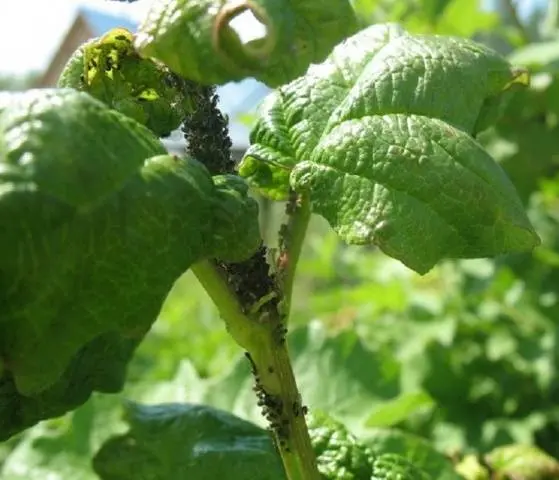
Types of currant aphids
Currant is a favorite berry shrub of many gardeners; they grow different types and varieties of these wonderful and healthy berries in their gardens. The first place in distribution is occupied by black currants, followed by red and yellow (white). In spring and early summer, when the bushes form young shoots and actively increase the green mass of leaves, they are in danger of being invaded by aphids – lovers of settling closer to the young shoots.
Aphids on blackcurrant
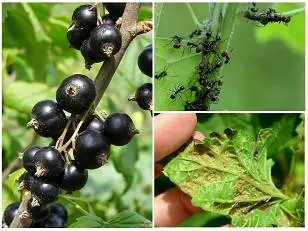
Name: shoot gooseberry (currant) aphid.
Characterization: body length from 2 to 2,5 mm, color is green, after the formation of wings the head and abdomen become black, in an adult female the cover is yellow-orange, the body of males is black.
Features: female aphids are able to lay eggs (black, shiny, oblong) 5-10 times per season, the last clutch hibernates on currant branches at the very base of the buds.
How to fight: manually cut off all the upper growths of the currant, where the bulk of the aphids settled, spray the bushes several times with chemical or biological products, apply folk remedies against aphids, feed the currants if they need additional fertilizer.
Aphids on redcurrant
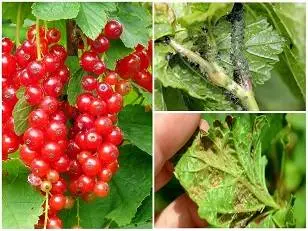
Name: gall leaf aphid (red currant).
Characterization: the body of the red gall aphid reaches a length of no more than 2,5 mm, it is painted in a pale yellow-green color, the surface of the body is covered with sparse hairs, the productivity of one female aphid is more than 200 eggs per season.
Features: gall aphid colonies live on the back of currant leaves, pierce them and suck out the juices, and the plant tries to heal the puncture sites on its own, as a result, growths form on the leaves in the form of galls – multi-colored (usually red-brown) formations, on the surface of the leaf they look like spherical swellings.
How to fight: in the first days, the reproduction of aphids on currants is restrained by cutting off leaves or cutting the tops of young shoots, where the main female lives with the “family”, if you’re lucky, she will disappear along with the removed parts of the plant. In the future, chemical and biological preparations and products prepared according to folk recipes are used.
Aphids on golden (white, yellow) currants
White currant, like red currant, is preferred by the same gall aphid, which breeds only on colored currant species. Its main characteristics and features are described above (see photo and section: aphids on red currants). The control measures are also identical.

Pest control
Every gardener with experience has his own favorite and proven over the years way of dealing with aphids on different types of currants, they pay a lot of attention in this fight to the prevention and protection of the plant, do everything so that the aphids do not settle on their currants, bypass, or rather, fly around by her side. We fully agree with experienced people, and we will start with preventive measures, we will advise novice lovers on how best to protect currant bushes even before the threat of aphid invasion.
Prevention and protection
What is prevention in crop production, many gardeners know, therefore, everywhere and constantly apply it in practice. For beginners, it is worth explaining that all measures aimed at protecting plants from the occurrence of a particular disease, as well as from the invasion of harmful horticultural insects, are called preventive measures that should not be neglected when caring for plants in gardens and orchards.
The first step in protecting currants from aphids: in early spring, all trees and shrubs in the garden, including currants, are treated with fungicides – chemical or biological preparations that can protect plants from fungal, viral, bacterial diseases, destroy pests, that is, protect currant bushes not only from aphids, but also others dangerous arthropods. The same means disinfect the soil. The eggs of many insect pests hibernate in the ground or on the plants themselves, by processing, you will destroy more of them.

The second stage of currant protection from aphids: in the spring, repellent plants are planted near the currants, which repel aphids from fruit bushes. Such plants that protect currant bushes include:
- onion garlic;
- spicy greens (parsley, basil, mint, coriander);
- other plants with a pungent odor (tansy, marigolds, tomatoes).
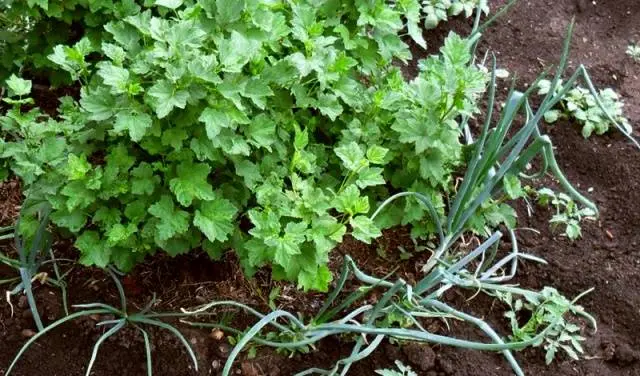
Planting repellent plants not only protects currant bushes from pests, but also benefits as excellent culinary seasonings, and if they are flowers, they perfectly complement the nooks of the garden with their color, in the center of which healthy currant bushes grow with beautiful bright berries.
The third stage of currant protection from aphids: before planting repellent plants, currants need to be fed, because after a long winter, the nutrient reserves in the soil have been depleted, and a weakened shrub will not be able to withstand the attack of aphids. At this time, that is, in early spring, the bulk of all the fertilizers required by the plant for the summer period are applied: manure, compost are laid out under the roots of the plant and dry mineral fertilizers are poured, the soil is dug up and loosened. Before flowering, currants are foliarly fertilized by spraying foliage and shoots with nutrient solutions. We will talk about what these solutions are a little later.
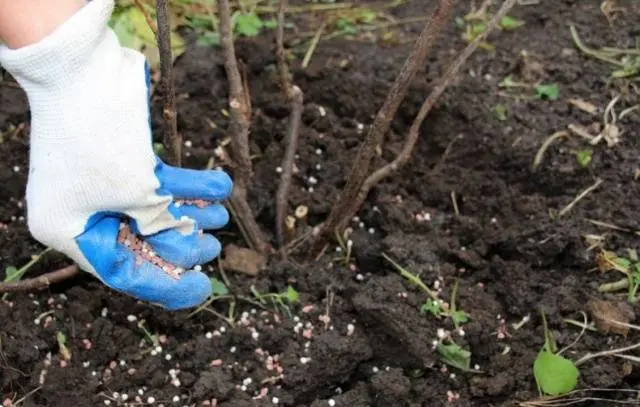
Drug treatment
Preventive measures are effective and efficient, but our currants are not immune from accidents, especially if there are negligent neighbors near your site who have not processed their plantings of currant bushes in time. Suppose that gusts of wind or ants brought aphids into your garden from a neighboring plot, and a hated aphid appeared on young growths of berry bushes. Hoping that you have protected the currant in the spring, you may not immediately notice that aphids eat it, and this is not the first day. It is still possible to save currants, but now one cannot do without the use of chemical or biological preparations, as well as household household products or infusions and decoctions prepared according to folk recipes.
- Chemicals: Karbofos, Aktara, Kinmiks, Tanrek.
- Biopreparations: Fitoverm, Bitoxicillin, Iskra-BIO. Biotlin, Antiant.
- Household products: ammonia, tar or laundry soap, soda, kerosene.
- Decoctions and infusions: from celandine, onions, wood ash, tobacco, potatoes (see recipes below).
Spraying currants should be carried out in the following way:
- time – evening hours;
- the weather is calm, windless;
- spraying – spray solutions from the sprayer on both sides of the leaves;
- the number of currant treatments – regularly, every 10-12 days, until all aphid colonies disappear.
Of all the types of currant, it will be easiest to get rid of aphids on blackcurrant, it is more resistant to aphids, after 2-3 sprays the aphids completely disappear from its leaves.
Resuscitation (scalding with boiling water)
Many gardeners have mastered the original method of saving currant bushes. In early spring, when the snow has not completely melted in the areas, they carry out shock resuscitation of dying currant bushes, pour boiling water or hot water over the bushes with a temperature of at least +70 ° C. Such treatment of plants, as experienced gardeners note, allows currants to be saved not only from aphids and many other harmful insects. Under the influence of high temperatures, all pathogens of viral and bacterial diseases die.
It is necessary to pour currants in the morning or afternoon on a sunny day, so that the bushes dry out in the sun after such a shower and do not freeze. A hot shower does not guarantee a 90% cure for a currant bush that is too affected, but in XNUMX% of cases the plant returns to full life and gives a decent harvest of berries in the coming season.
Traditional recipes
For those gardeners who are not ready to use pesticides on their plots, we have prepared several recipes for preparing products that are safe and harmless to humans and the environment:
- onion infusion: pour 250-300 g of chopped onions into a bucket of water (you can take unpeeled onions), close the lid, hold for 1-2 days, strain, spray 2-3 times;
- ash decoction: boil a bucket of water with 500 g of wood ash, after 2 hours add 50 g of laundry or tar soap, mix and strain through cheesecloth so that small particles do not clog the sprayer mesh, treat currants 2-3 times;
- tobacco leaf extract: Pour 300-400 g of tobacco leaves with boiling water (5 liters), tightly close the container with a lid, leave to cool completely, filter, spray currant bushes 2-3 times per season.
- infusion of celandine: chop fresh celandine sprigs into pieces up to 5 cm, fill a bucket halfway with them, pour boiling water or hot water (+ 70 ° C), cool, spray currants several times with intervals of 7 days.
The use of folk remedies does not threaten the environment, so you can use them in any growing season of the plant, you can alternate different decoctions and infusions so that the aphids cannot adapt (get used) to any one of them, then the fight against aphids can become more effective. A lively and cheerful lover of berries talks about her method of processing plants from aphids in a video, look and smile.
Attract beneficial insects and birds to the garden
Aphids, sucking juices from plants, supply themselves with many nutrients, in addition, they secrete honeydew that tastes sweet, which attracts predatory insects: ladybugs and their larvae, lacewings and sand wasps. When meeting with aphids, they are not averse to feasting on it: crickets, ground beetles, earwigs, spiders, hoverflies. By devouring the harmful aphids on the currant, they save the plant.
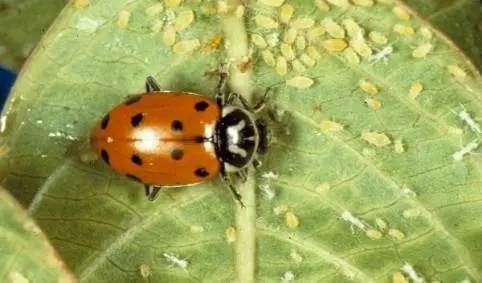
Rescuers need to be lured with something, so you need to know their habits: earwigs like to hide in wood shavings, so you need to put a container (box, bucket, pot) with such a shelter next to currants, hoverflies are attracted by the pungent smell of dill, plant a few bushes near currants and everyone will be happy.
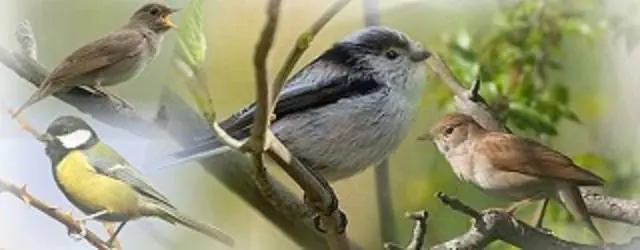
Many species of birds also destroy aphids, feeding on them and feeding their chicks, to attract birds to your garden, arrange feeders, drinkers, birdhouses. The main species of birds that eat aphids are starlings, titmouses, warblers, sparrows and all forest birds. For them, aphids are an excellent supplier of glucose and other carbohydrates. One bird is able to rid the garden of many individuals of harmful insects per day, including up to 200-300 female and male aphids.
By fighting aphid colonies, you also clear the gardens of ants, aphids will disappear from your plots, ants will leave after them.
Conclusion
Caring for the garden and garden for most amateur gardeners is not forced work, for them it is a manifestation of their feelings for everything around them, because a person who loves plants cannot not love his relatives and friends, not take care of them just like green pets in the garden. It costs a lot. Native people, Fatherland, Nature – there is nothing more precious than this, love them and take care of them all your life.
For a complete overview of how to deal with aphids on currants, we have placed useful videos in a way that is impossible to tell about everything within one article. Watch, learn, apply. Good luck.









